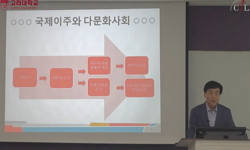이 연구의 목적은 일본 귀환 일계인의 민족정체성 형성과 유형을 고찰하는데 있다. 19세기 중반 하와이로 떠난 일본인들은 20세기 초기 남미브라질로 향했다. 당시 일본인 이주자들은 농촌지...
http://chineseinput.net/에서 pinyin(병음)방식으로 중국어를 변환할 수 있습니다.
변환된 중국어를 복사하여 사용하시면 됩니다.
- 中文 을 입력하시려면 zhongwen을 입력하시고 space를누르시면됩니다.
- 北京 을 입력하시려면 beijing을 입력하시고 space를 누르시면 됩니다.
https://www.riss.kr/link?id=A103125207
- 저자
- 발행기관
- 학술지명
- 권호사항
-
발행연도
2015
-
작성언어
Korean
- 주제어
-
자료형태
학술저널
-
수록면
37-53(17쪽)
- 제공처
-
0
상세조회 -
0
다운로드
부가정보
국문 초록 (Abstract)
일본인들이 본격적으로 이주한지 1세기가 지난 20세기 말, 일본산업구조의 변화와 저출산고령화에 따른 노동력 부족으로 1990년 이후 브라질에서 일본으로 일계인 노동자 약 30만 명이 귀환하게 되었다. 이들 가운데 2008년 전 세계적인 금융위기를 계기로 약 10만 명 가량이 브라질로 귀국하게 되었다. 그 과정에서 일계인들은 민족정체성의 재편을 가져오게 되었다. 이 연구는 일계인의 민족정체성 형성과 재편의 원인을 규명하는데 있다. 기존 연구에서는 일계인 노동자의 브라질 귀환에 대하여 리먼쇼크의 경제적 위기로 인한 실업문제가 가장 큰 원인이라는 것이 설득력을 얻고 있다. 그러나 이 연구에서는 민족차별에 따른 민족정체성의 재편 과정을 살펴보았다는 점에서 다른 연구와 차별성을 가지고 있다.
연구결과는 다음과 같다.
첫째, 일계인의 민족정체성은 도일 전 브라질에서는 모국신화에 따른 일본인의 정체성을 지향하고 도일 후 일본에서는 일본사회의 민족차별경험으로 일계인의 정체성을 지향하는 것으로 나타났다.
둘째, 요인분석결과 일계인의 민족정체성은 ‘일본인 정체성’, ‘일계인 정체성’, ‘제3의 혼합형 정체성’을 지향하는 것으로 나타났다.
셋째, 상관분석결과 일계인들은 일본사회에서 민족차별의 인식이 강할수록 일계인으로서의 민족정체성의 인식도 강하게 나타났다.
결론적으로 일계인의 민족정체성은 브라질에서 일본인 정체성이 강하지만 점차 일본사회에서 민족차별 경험으로 일계인으로서의 정체성, 혹은 혼합형 정체성을 자각하게 되는 것으로 나타났다. 이러한 연구결과는 일계인들이 일본사회에서 민족차별에 따른 사회적 적응실패를 경험하게 되는 것을 의미한다. 또한 일본정부가 일계인의 일본정착을 위한 일관된 이민정책을 수립하지 못하고 있다는 것을 반증하고 있는 것으로 생각된다.
이 연구의 목적은 일본 귀환 일계인의 민족정체성 형성과 유형을 고찰하는데 있다. 19세기 중반 하와이로 떠난 일본인들은 20세기 초기 남미브라질로 향했다. 당시 일본인 이주자들은 농촌지역 출신의 데카세기(돈벌이) 노동자들이 대부분이었다.
일본인들이 본격적으로 이주한지 1세기가 지난 20세기 말, 일본산업구조의 변화와 저출산고령화에 따른 노동력 부족으로 1990년 이후 브라질에서 일본으로 일계인 노동자 약 30만 명이 귀환하게 되었다. 이들 가운데 2008년 전 세계적인 금융위기를 계기로 약 10만 명 가량이 브라질로 귀국하게 되었다. 그 과정에서 일계인들은 민족정체성의 재편을 가져오게 되었다. 이 연구는 일계인의 민족정체성 형성과 재편의 원인을 규명하는데 있다. 기존 연구에서는 일계인 노동자의 브라질 귀환에 대하여 리먼쇼크의 경제적 위기로 인한 실업문제가 가장 큰 원인이라는 것이 설득력을 얻고 있다. 그러나 이 연구에서는 민족차별에 따른 민족정체성의 재편 과정을 살펴보았다는 점에서 다른 연구와 차별성을 가지고 있다.
연구결과는 다음과 같다.
첫째, 일계인의 민족정체성은 도일 전 브라질에서는 모국신화에 따른 일본인의 정체성을 지향하고 도일 후 일본에서는 일본사회의 민족차별경험으로 일계인의 정체성을 지향하는 것으로 나타났다.
둘째, 요인분석결과 일계인의 민족정체성은 ‘일본인 정체성’, ‘일계인 정체성’, ‘제3의 혼합형 정체성’을 지향하는 것으로 나타났다.
셋째, 상관분석결과 일계인들은 일본사회에서 민족차별의 인식이 강할수록 일계인으로서의 민족정체성의 인식도 강하게 나타났다.
결론적으로 일계인의 민족정체성은 브라질에서 일본인 정체성이 강하지만 점차 일본사회에서 민족차별 경험으로 일계인으로서의 정체성, 혹은 혼합형 정체성을 자각하게 되는 것으로 나타났다. 이러한 연구결과는 일계인들이 일본사회에서 민족차별에 따른 사회적 적응실패를 경험하게 되는 것을 의미한다. 또한 일본정부가 일계인의 일본정착을 위한 일관된 이민정책을 수립하지 못하고 있다는 것을 반증하고 있는 것으로 생각된다.
다국어 초록 (Multilingual Abstract)
The findings of this study are as follows:
First, Nikkeijin’s ethnic identity intends Japanese"s identity in Brazil and intended Nikkeijin"s identity to distinction experience of Japanese society in Japan.
Second, according to factor analysis, Nikkeijin"s ethnic identity intended Japanese identity , Nikkeijin identity, Mixed type identity etc.
Third, according to correlation analysis, Nikkeijin is encountering ethnic distinction on Japanese society, was expose that nikkeijin"s identity is strong.
In conclusion, the findings of the study suggest that Nikkeijin means failure of social acculturation by ethnic distinction on Japanese society. Also, it is disproving that Japanese government is not establishing immigration policy for Nikkejin"s Japanese adaptation
The purpose of this study is to analyze some return Nikkeijin’s ethnic identity formation and type. In the middle of the 19th century Japanese people departed to Hawaii and then in the beginning of 20th century they headed to South American Brazil. ...
The purpose of this study is to analyze some return Nikkeijin’s ethnic identity formation and type. In the middle of the 19th century Japanese people departed to Hawaii and then in the beginning of 20th century they headed to South American Brazil. In Dekasegi most of lowlanders and labor workers were Japanese emigrants from rural areas. In the end of the 20th century, after 100 years of migration there were changes with industrial structure of low birthrate and aging population of Japanese. From second half of 1990 approximately 300,000 of Nikkeijin which lived in Brazil returned back to Japan. Because of financial crisis in 2008 they had opportunity to comeback. Approximately 100,000 people returned back to Brazil. This study is examining closely cause of these Nikkejin"s ethnic identity formation and reconfiguration.
The findings of this study are as follows:
First, Nikkeijin’s ethnic identity intends Japanese"s identity in Brazil and intended Nikkeijin"s identity to distinction experience of Japanese society in Japan.
Second, according to factor analysis, Nikkeijin"s ethnic identity intended Japanese identity , Nikkeijin identity, Mixed type identity etc.
Third, according to correlation analysis, Nikkeijin is encountering ethnic distinction on Japanese society, was expose that nikkeijin"s identity is strong.
In conclusion, the findings of the study suggest that Nikkeijin means failure of social acculturation by ethnic distinction on Japanese society. Also, it is disproving that Japanese government is not establishing immigration policy for Nikkejin"s Japanese adaptation
목차 (Table of Contents)
- 〈Abstract〉
- 〈국문요약〉
- Ⅰ. 서론
- Ⅱ. 선행연구 및 이론적 배경
- Ⅲ. 연구방법 및 분석절차
- 〈Abstract〉
- 〈국문요약〉
- Ⅰ. 서론
- Ⅱ. 선행연구 및 이론적 배경
- Ⅲ. 연구방법 및 분석절차
- Ⅳ. 일계인 민족차별에 따른 민족정체성 형성과 정체성 유형에 관한 분석
- Ⅴ. 결론 및 시사점
- 〈참고문헌〉
동일학술지(권/호) 다른 논문
-
- 전남대학교 글로벌디아스포라연구소
- 김나경(Kim, Na-Kyung)
- 2015
-
- 전남대학교 글로벌디아스포라연구소
- Park, Cheol-Soo(박철수)
- 2015
-
The Japanese diaspora to the US
- 전남대학교 글로벌디아스포라연구소
- Joseph Tomei
- 2015
-
- 전남대학교 글로벌디아스포라연구소
- Hirohiko Nakafuji
- 2015




 DBpia
DBpia






